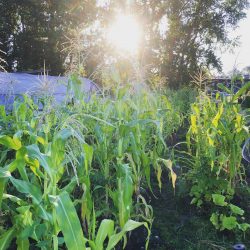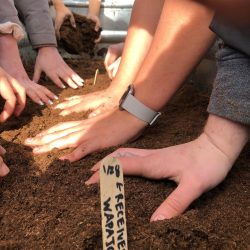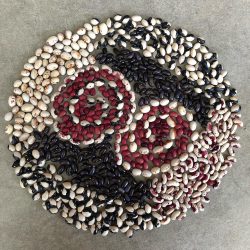Tucked into a corner of the UW Farm at the Center for Urban Horticulture, within the moist compost and woven through the tendrils of beans, a community flourishes. The wǝɫǝbʔaltxʷ Native Garden is a unique space where crops and people grow in harmony. Informed by traditional farming practices, the Native Garden serves as a space for Indigenous students to connect with their culture and share it with the broader community.
“We are trying to share Indigenous food ways, ways of farming and food sovereignty with anybody who is interested,” said Sarai Mayer, the Native Garden’s food sovereignty liaison. “We are trying to spread awareness and get people involved in the process of working the land and allowing access to food. Everyone benefits when Indigenous people are allowed access to the land.”

Beginning in 2018, a range of foods, plants and medicines are grown at the Native Garden, including several types of corn, squash, beans, Wapato, rare potatoes, amaranth and ceremonial tobacco. Growing corn, beans and squash uses the traditional “Three Sisters” method, where the runner beans grow up the corn stalks, using them as structural support; the beans help fix nitrogen in the soil to keep it healthy; and the squash offers shade to keep the soil moist and free of weeds. The fallen squash leaves even serve as compost. Amaranth or sunflowers can be used as a fourth sister because their fibrous roots hold the mounds of soil together. Once harvested, eating corn, beans and squash is a complete diet full of essential nutrients, vitamins and minerals.
As the University of Washington is increasing conversations around diversity, equity and inclusion, the Native Garden is a place where those values are put into action. According to Perry Acworth, the UW Farm manager, there’s something to be said about “going outside, putting your hands in the dirt, and visibly making a physical change. It’s an actual space where you can make a difference in a very short period of time.”
The Native Garden exists as a partnership between UW Farm — housed in the College of the Environment — and the wǝɫǝbʔaltxʷ – (Intellectual House) on the UW Seattle campus. wǝɫǝbʔaltxʷ (a Lushootseed word, phonetically pronounced “wah-sheb-altuh”) – Intellectual House is a longhouse-style building meant to serve as a community and cultural gathering space for Indigenous students, staff and faculty.

The Garden serves a similar purpose, and is also a place where students organize and connect with their culture and food systems. Mayer is the first food sovereignty liaison employed through wǝɫǝbʔaltxʷ – Intellectual House, where she spends a lot of time finding out what people want from the garden. “It’s not my garden, it’s our garden,” she said, “and I’m trying to facilitate what people want and need from that.” The garden provides an opportunity to reconnect with the land and food system, allowing Indigenous students to get involved in a holistic system of planting, harvesting and processing food. “I think there’s a lot to learn from being part of the entire process of planting them, nourishing them and caring for them as they care for us,” Mayer explained.
According to Mayer, it’s not just the Native American community that benefits from having this space on campus; everyone has something to learn from seeing and experiencing it: “we can build this connection not only with the earth, land and plants, but with other people. These connections cross cultures and allow us to be part of a shared humanity.”
Acworth agrees that the garden opens doors for learning opportunities beyond the classroom. “Topics are brought up by class, but they get into really deep discussions while harvesting carrots, while picking kale, because it’s a very organic space. It’s a living laboratory and it’s a classroom with no walls.”
The location and the land on which the Native Garden exists is one of historical significance to many Coast Salish peoples, and has gone through many transformations. It was once home to several Coast Salish longhouses and a fishing weir. “Canoes would have been pulled up here, and it would have been an area with a lot of activity,” Acworth said. “There was a slough, or a creek, that goes up to Green Lake where people would have caught fish. The slough runs along the Union Bay Natural Area, which is adjacent to the farm.” But in the late 1800’s, early settlers connected Lake Washington and Lake Union with a large industrial canal, lowering the water in Lake Washington and Union Bay by several feet. This created marshland thought to be unusable at that time, which soon became the Montlake Dump. After the dump closed in 1966, the University began planning for and using the land in different ways, including what would eventually become the Center for Urban Horticulture. Acworth says that offering space for the Native Garden can be seen as unofficially re-matriating land back to Indigenous peoples, and is one step towards honoring and acknowledging in a physical and symbolic way the original inhabitants.

An important aspect of the garden is that it provides food security to Indigenous students, volunteers and community members. People who volunteer at the farm and in the Native Garden often earn food for their hard work. Excess food grown at the UW Farm is brought to the UW Food Pantry to support food insecure students that are unable to volunteer. There’s an academic benefit to this as well — when students are food insecure, they are half as likely to graduate.
Mayer is hoping to implement community activities that involve more than just food, like hosting workshops to make paper from corn byproducts, dye from sunflowers or dolls from corn husks. The garden also hopes to have a Cultural Kitchen onsite soon, where community members and elders can come to prepare food. Acworth says, “not only will it be a place of food growing, but a place of food consumption and a place of sharing stories, harvesting and eating together.” Mayer also hopes to establish a pathway to get food and medicine produced in the garden to community members and elders that need it, such as ceremonial tobacco.
The Native Garden exemplifies the spirit of UW’s diverse community, and provides an outlet for students to share their culture and values with others. “It really opens the door for people to ask questions to learn about what we are doing, how we are self-actualizing and what it’s like to be Native in a modern sense,” Mayer said. “We are doing real work, and we are here, and we are present and we want people to be a part of that. Just existing and having people see us doing that work, and know that they also have something to gain from it too, is incredibly important.”
The Native Garden has been supported by funding from the Na’ah Illahee Fund, a UW Campus Sustainability Grant and the College of the Environment graduating class of 2021. In addition to Mayer, Kamaka’ike Natalie Bruecher, Magnus Jim and Sierra Red Bow have all been Native Garden food sovereignty liaisons.
To volunteer in the spring and summer, contact Sarah (Sarai) Mayer: slemayer@uw.edu. Everyone is welcome to volunteer.
For more info on ways to get involved and stay up to date, check out:
UW Farm Newsletter — The Weekly Dirt

